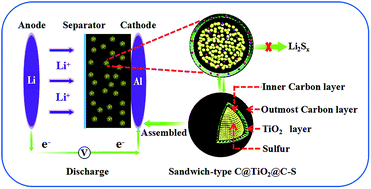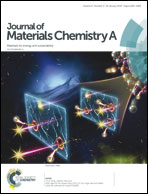Design and synthesis of novel sandwich-type C@TiO2@C hollow microspheres as efficient sulfur hosts for advanced lithium–sulfur batteries†
Abstract
Lithium–sulfur (Li–S) batteries are considered as next generation efficient energy storage systems due to their high theoretical energy densities and low cost. When carbonaceous materials being used as cathode for Li–S batteries, the dissolution of intermediate polysulfides coupled with large volume expansion and low electronic and ionic conductivity of solid S-related species has resulted in poor cycle performance and low capacity. In this work, novel sandwich-type carbon/titanium dioxide/carbon (C@TiO2@C) hollow microspheres as a new kind of molecularly designed physical and chemical trap for lithium polysulfides (Li2Sx (x = 4–8)) are reported. In such a unique architecture, an interlay TiO2 layer as the carrier for sulfur could effectively confine polysulfides by chemical binding between TiO2 and polysulfides, while the sandwich-type hollow carbon structure could buffer the volume change during the charge–discharge process by means of physical force. Moreover, the inner and outmost carbon layers provide an effective conductive network to improve the electronic conductivity of sulfur cathodes, and at the same time further suppress the dissolution of polysulfides, leading to structural and interfacial stabilization of the TiO2 interlay. Benefiting from the synergistic encapsulation, the developed C@TiO2@C–S hybrid hollow microspheres with 76.4 wt% sulfur content deliver a high specific capacity of 1247.3 mA h g−1 at 0.2C with higher coulombic efficiency (≈96%), and retain a discharge capacity of 741.3 mA h g−1 after 300 cycles at 0.5C and 511 mA h g−1 after 500 cycles at 2C, which are much better than those of the contrast TiO2–S and C@C–S electrodes.



 Please wait while we load your content...
Please wait while we load your content...